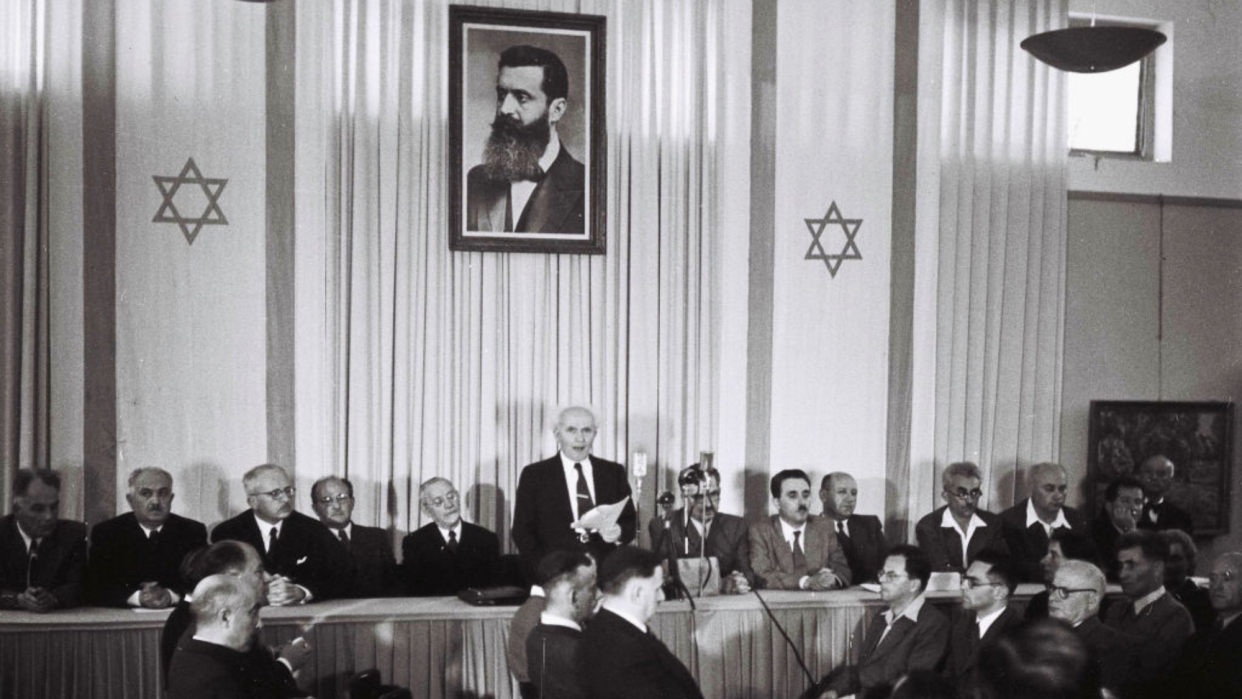The creation of modern Israel

- Oops!Something went wrong.Please try again later.
How did the conflict start?
Even that is a contentious question, but most historians begin the story with the first waves of modern Jewish migration to the Holy Land, in the 1880s. By the mid 19th century, the Jewish population of the region, then controlled by the Ottoman empire, was small: about 10,000 strong.
But the dream of a home in Biblical Israel was deeply rooted in the culture of the Jewish diaspora, and modern Zionism emerged as a force at this time, fed by increasingly virulent antisemitism in Europe, particularly pogroms in Poland and Russia. The first Zionist Congress was held in Basel in 1897, and declared as its aim "the creation of a home for the Jewish people in Palestine". By 1914, the Jewish population of the area had grown to 85,000, perhaps a tenth of the total. Most of the new arrivals came from Russia, Romania and Yemen.
How did Zionism develop?
The situation changed profoundly with the conquest of swathes of the Ottoman empire by Britain during the First World War. In 1920, Britain was awarded a mandate over the newly created territory of Palestine by the League of Nations (at first it also included Transjordan, today's Jordan, from which it was separated in 1923).
During the War, British officials had promised self-determination to the Arab population, to secure their support. However, in 1917, the British foreign secretary Arthur Balfour had made a conflicting promise, declaring that the British government viewed "with favour the establishment in Palestine of a national home for the Jewish people". After the War, Britain supported Jewish migration, but soon imposed strict quotas because of Arab objections.
How did the situation change in the 1930s?
The rise of Hitler meant that some 170,000 European Jews fled to Palestine between 1933 and 1936, doubling its Jewish population. Most settled in the cities – including their own new port, Tel Aviv – but some bought farms and set up communal kibbutzim, mostly in the coastal plains, not in Biblical Israel (the hilly interior around Jerusalem).
The Jewish community established a thriving parallel society, with its own tax system and militias, and even their own language (Hebrew had been revived). As it grew, tensions with Arab populations mounted sharply; there were regular eruptions of intercommunal violence. The Arabs mounted a national strike in 1936, leading Britain to pause immigration. Then, in 1937, Britain proposed partitioning the country to create two states; this would have meant moving many Arabs out of the new Jewish lands. This plan was shelved after a major Arab revolt, put down by the British with brutal force.
Why was Palestine partitioned?
Britain concluded that Arab and Jewish claims were irreconcilable; and in the 1940s, Zionist resolve to create a Jewish state understandably hardened, leading to a guerilla campaign against British rule. After the Second World War, Britain turned to the newly formed UN for help. After the Holocaust, the moral case for a Jewish homeland – and a safe place for homeless, stateless Jewish refugees – was widely accepted by world opinion (if not by Arab opinion).
In 1947, the UN General Assembly voted for a partition plan, by 33 nations to 13 (the UK abstained). This plan gave 55% of Palestine to the Jewish state, although Jews made up a third of its population (and owned 8% of its private land). The Arab majority would get 43%; Jerusalem would be an international city.
Was the proposal implemented?
The Jewish community accepted the UN partition. "Erect a Jewish state at once," wrote David Ben-Gurion, Israel's first PM, "even if it is not in the whole land." The British cut and ran; the last chief secretary, Sir Henry Gurney, left the keys to his office in Jerusalem under the mat.
The State of Israel was proclaimed on 14 May 1948, in the midst of what would become a civil war between Jews and Arabs; and, on 15 May, neighbouring Arab states – Egypt, Jordan, Syria, Lebanon and Iraq – entered the conflict to destroy the nascent Israeli state. The Arab armies were defeated, and Israel expanded to fill 78% of mandate Palestine in total, while the Palestinian areas of the West Bank along with East Jerusalem, and the Gaza Strip, were annexed by Jordan and Egypt respectively. Truces were agreed in 1949; an armistice line (the "green line") was set, without a peace agreement.
What was the Palestinian response?
Palestinian leaders had rejected the UN plan, since it was evidently disastrous to their people. But the result – known as the Nakba, "the catastrophe" – was more disastrous still.
By 1949, Palestine had disappeared from the map. Half the Palestinian population, some 750,000, had fled or been expelled; there were atrocities on both sides, but the stronger Israeli forces depopulated hundreds of Arab towns and villages. About 400,000 went to Jordan, 150,000 to Lebanon and Syria, 200,000 to Gaza. About 160,000 Palestinians remained in Israel: some 20% of the population.
How did Israel occupy the rest of mandate Palestine?
There were renewed rounds of fighting between Israel and its neighbours, particularly Egypt under the Arab nationalist Gamal Abdel Nasser. In June 1967, Egypt closed the Red Sea to Israeli shipping and mobilised troops close to its border; Israel attacked pre-emptively, capturing the Gaza Strip and all the Sinai Peninsula. Jordan and Syria entered the war, but the Israelis counterattacked, capturing the West Bank and East Jerusalem from Jordan, as well as Syria's Golan Heights.
The Six Day War was a great triumph for the young Israeli state, but it initiated a long military occupation of Palestinian territory, which the UN deemed illegal. Israel was militarily dominant, but still surrounded by enemies. In 1967, the Arab League met in Khartoum to give its "three nos": no peace with Israel, no recognition of Israel, no negotiations with Israel.

